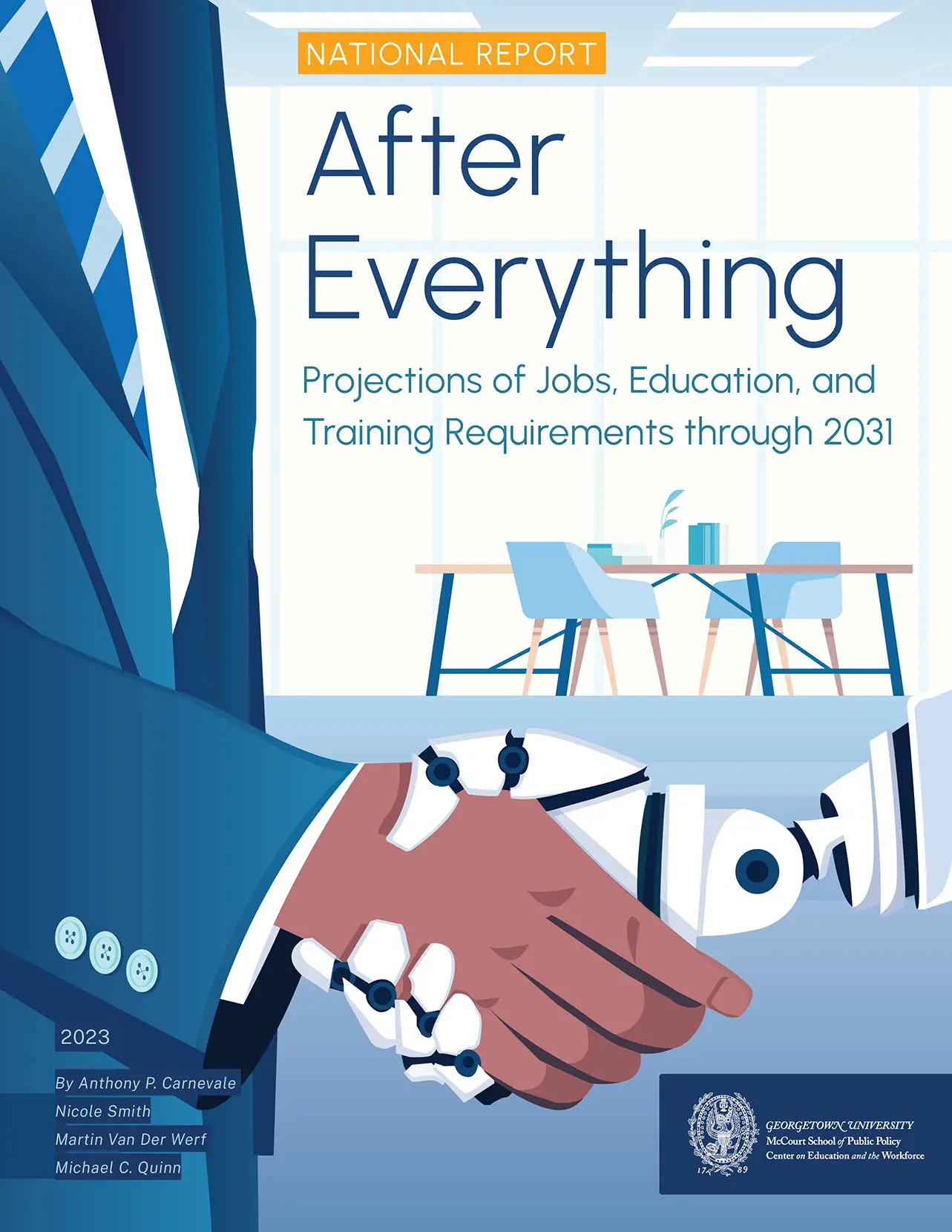Summary
By 2031, 72 percent of jobs in the US will require postsecondary education and/or training. Between 2021 and 2031, there will be 18.5 million job openings per year on average, and some 12.5 million of these annualized openings will require at least some college education. After Everything: Projections of Jobs, Education, and Training Requirements through 2031 includes a national overview of job projections and their educational requirements across industries, occupational clusters, and detailed occupational groups. These latest projections demonstrate the central role postsecondary education plays in preparing the workforce of the future.
Source: Georgetown University Center on Education and the Workforce forecast using data from the US Census Bureau and Bureau of Labor Statistics, Current Population Survey (CPS); US Census Bureau, American Community Survey (ACS); US Bureau of Labor Statistics; IHS Markit; Lightcast; and US Census Bureau and Bureau of Labor Statistics, Current Population Survey (CPS), 1983.
*Note: Before 1992, the education variable in the Current Population Survey was identified as years of schooling. We are therefore unable to differentiate between “some college or certificate” and “associate’s degree” in those years.
Columns may not sum to 100 percent due to rounding
A Bifurcated Economy
Increasingly, the labor force is being divided into two economies: the managerial and professional economy, in which most workers have postsecondary education, and the blue-collar and skilled-trades economy, in which just a little more than half of workers have college educations.
The Managerial and Professional Economy
The managerial and professional economy consists of five occupational clusters: science, technology, engineering, and mathematics (STEM) and social sciences; education; healthcare professional and technical; community services and arts; and managerial and professional office. Between 2021 and 2031, across these occupational clusters, 95 percent of the total job openings will require at least some postsecondary education.
The Blue-Collar and Skilled-Trades Economy
The blue-collar and skilled-trades economy consists of the following four occupational clusters: sales and office support, healthcare support, food and personal services, and blue-collar. Between 2021 and 2031, across these occupational clusters, 42 percent of the total job openings will be available to workers with a high school diploma or less.
Job Projections through 2031 by Occupation
The fastest-growing industries require workers with disproportionately higher education levels compared to industries with slower growth. Between 2021 and 2031, all industries are expected to see increases in employment, but healthcare services, professional and business services, government and public education services, and leisure and hospitality services will grow the fastest.
The required educational concentrations for job openings from 2021 to 2031 in each educational category are projected as follows:
Source: Georgetown University Center on Education and the Workforce forecast using data from the US Census Bureau and Bureau of Labor Statistics, Current Population Survey (CPS); US Census Bureau, American Community Survey (ACS); US Bureau of Labor Statistics; IHS Markit LLC; and Lightcast.
Note: Columns may not sum to 100 percent due to rounding.
Job Projections through 2031 by Industry
Occupations tend to have similar educational requirements regardless of the industry in which they are located, though particular competencies can be industry-specific. Occupations as a whole are steadily requiring more education as tasks within occupations become more complex.
Source: Georgetown University Center on Education and the Workforce forecast using data from the US Census Bureau and Bureau of Labor Statistics, Current Population Survey (CPS); US Census Bureau, American Community Survey (ACS); US Bureau of Labor Statistics; IHS Markit LLC; and Lightcast.
*Middle skills are jobs that require education beyond high school, including associate’s degrees, postsecondary vocational certificates and test-based industry certifications, and some college but no degree.
Note: Columns may not sum to 100 percent due to rounding.
Education Requirements
The fastest-growing occupation and industry sectors are those that have workers with the most postsecondary education and training. The economy will continue to create jobs for workers with a high school diploma or less, but these jobs, in many cases, do not offer high enough earnings for the workers who hold them to achieve upward economic mobility. The labor force will be increasingly divided between those who have postsecondary education and those who don’t. It is becoming ever clearer that postsecondary education or training is the only path to a middle-class lifestyle for most workers.
Resources
After Everything: Projections of Jobs, Education, and Training Requirements through 2031 finds that higher levels of educational attainment are crucial to preparing the nation for the future of work.
Forecasted job growth for all 50 states and the District of Columbia from 2021 through 2031.
The technical report is a detailed explanation of CEW’s methodological approach.

